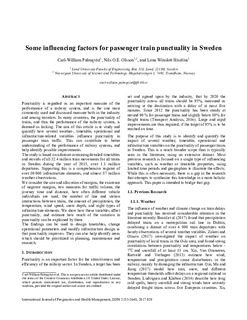| dc.contributor.author | Palmqvist, Carl-William | |
| dc.contributor.author | Olsson, Nils | |
| dc.contributor.author | Hiselius, Lena | |
| dc.date.accessioned | 2018-01-03T11:28:57Z | |
| dc.date.available | 2018-01-03T11:28:57Z | |
| dc.date.created | 2017-10-02T10:52:53Z | |
| dc.date.issued | 2017 | |
| dc.identifier.citation | International Journal of Prognostics and Health Management. 2017, 8 . | nb_NO |
| dc.identifier.issn | 2153-2648 | |
| dc.identifier.uri | http://hdl.handle.net/11250/2474320 | |
| dc.description.abstract | Punctuality is regarded as an important measure of the performance of a railway system, and is the one most commonly used and discussed measure both in the industry and among travelers. In many countries, the punctuality of trains, and thus the performance of the railway system, is deemed as lacking. The aim of this article is to study and quantify how several weather-, timetable, operational and infrastructure-related variables influence punctuality in passenger train traffic. This can contribute to better understanding of the performance of railway systems, and help identify possible improvements.
The study is based on a dataset containing detailed timetables and records of all 32.4 million train movements for all trains in Sweden during the year of 2015, over 1.1 million departures. Supporting this is a comprehensive register of over 80 000 infrastructure elements, and almost 87 million weather observations.
We consider the size and allocation of margins, the existence of negative margins, two measures for traffic volume, the journey time and distance, how often different vehicle individuals are used, the number of line and station interactions between trains, the amount of precipitation, the temperature, wind speed, snow depth, and eight types of infrastructure elements. We show how these variables affect punctuality, and estimate how much of the variation in punctuality can be explained by them.
The findings can be used to design timetables, change operational parameters and modify infrastructure design so that punctuality improves. They can also help identify areas which should be prioritized in planning, maintenance and research. | nb_NO |
| dc.language.iso | eng | nb_NO |
| dc.publisher | Prognostics and Health Management Society | nb_NO |
| dc.relation.uri | http://www.phmsociety.org/journal | |
| dc.rights | Navngivelse 4.0 Internasjonal | * |
| dc.rights.uri | http://creativecommons.org/licenses/by/4.0/deed.no | * |
| dc.title | Some Influencing Factors for Passenger Train Punctuality in Sweden | nb_NO |
| dc.type | Journal article | nb_NO |
| dc.type | Peer reviewed | nb_NO |
| dc.description.version | publishedVersion | nb_NO |
| dc.source.pagenumber | 13 | nb_NO |
| dc.source.volume | 8 | nb_NO |
| dc.source.journal | International Journal of Prognostics and Health Management | nb_NO |
| dc.identifier.cristin | 1501307 | |
| dc.description.localcode | Carl-William Palmqvist et al. This is an open-access article distributed under the terms of the Creative Commons Attribution 3.0 United States License, which permits unrestricted use, distribution, and reproduction in any medium, provided the original author and source are credited. | nb_NO |
| cristin.unitcode | 194,64,92,0 | |
| cristin.unitname | Institutt for maskinteknikk og produksjon | |
| cristin.ispublished | true | |
| cristin.fulltext | preprint | |
| cristin.qualitycode | 1 | |

